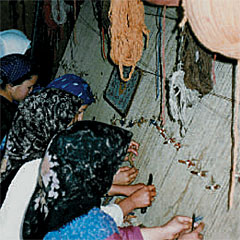home > carpet news > magazine features > oriental carpet making
Oriental Carpet Making
Reproduced with kind permission of Carpet and Flooring Review
Are natural dyes better and how important is the number of knots? Richard Mathias gives the lowdown on how to sell the individuality of this traditional weaving
A hand made oriental rug is made to last and will give many years of service. It is created in a number of logical stages, with materials varying according to the location of the maker.
The materials or yarn used are greatly dependant on the resources available to the weavers. Nomadic weavers are less likely to use cotton or silk since wool is the most readily available material for them. Their herds of sheep and goats provide them with the essential means to produce a durable rug. The location of the grazing, good climate and altitude, age of sheep and the time of the year for shearing are all important factors in getting the best wool. Shoulder wool is the longest, and most expensive, and is ideal for rug weaving.
 Cotton is often used for the warps and wefts because it is stronger and holds its shape better, especially after washing (although nomadic rugs are often 100% wool).
Cotton is often used for the warps and wefts because it is stronger and holds its shape better, especially after washing (although nomadic rugs are often 100% wool).
In early carpet weaving, the only method of colouring the wool was by producing natural dyes from boiled vegetable and plant roots. Some weavers still use traditional methods to produce wonderful varieties of hue and colour, which mellow with age.
Natural dyes include madder for reds, indigo for blues, yellows from Persian berries, larkspur and turmeric. Also used are catechu, walnut husks and pomegranate rind for browns and logwood with iron for black.
Since the discovery of coal-tar dyes in 1856, a large number of colours obtained by chemical processes have come into use. Nowadays, new colours of the highest quality are known as ‘chrome’ dyes which resist acids, alkalis and light, do not harm the wool, and do not run or streak. These also have the advantage of adding moth proofing and dirt and stain resistance.
So natural dyes are not always better, even though their look is very difficult to achieve with chemical dyes, however good.
The loom is essentially a frame for holding the warp threads in their correct positions. The warps are the parallel threads running through the entire length of the rug on to which the knots are ‘tied’. The weft threads then run across the width of the rug, inserted between all the rows of knots and passing through alternate warp threads in an ‘over and under’ motion. Their job is to secure the knots.
The knot is the term used for a strand of wool yarn which is looped around two adjacent warp threads and then cut to form the pile. The knots are tied in horizontal rows across the carpet at right-angles to the warp threads with the free ends forming a unit of the pile. However carefully the knotting is done, the surface is bound to be more or less irregular, so that a final operation is to lip the ends of the pile with shears and bring it to a uniform level.
The best index of the general ‘fineness’ (but not quality or value) of a rug is the number of knots to the square inch, which can be determined by multiplying the number of knots to the linear inch in each direction. This can vary from 20 to 600, although an exceptionally fine example can hold almost 1,000.
After about a few rows of knots are tied across the width of the loom, the weaver beats down the warps and rows of knots using a beater or comb. Once a strip of pile about an inch or so wide is woven across the width of the loom, the weaver clips back the nap.
In knotted rugs there are also two major kinds of weave or knot, the Turkish (or Ghiordes) knot and the Persian (or Senneh) knot. A more inferior Jufti knot is occasionally used, but it is less desired as it uses half the number of knots, hence less wool and half the amount of time. The Persian knot is seen as more popular than the Turkish since there are fewer gaps between each knot, the knots are less bulky, and the method creates better curves and can make a finer design.
A simple wrapping of dyed yarn, referred to as a ‘selvedge’, binds the entire length of both sides of the rug. Occasionally goat or camel hair is used as selvedge to strengthen the binding. The ends of the rug may be finished off in a variety of ways, but the most common is by use of a fringe. The continuation of the warp threads at both ends of the rug can be tied in different ways.
A pileless web of weft and warp threads is used to make a kelim also known as a ‘flatweave’. Different methods of weaving kelims include slit-weave and soumak. Like many features of oriental rugs, there is a great deal of complexity in the methods of weaving used, making it essential to buy only from reputable dealers.
